
Anxiety is one of the most common mental health disorders among children and adolescents. During puberty, various psychological and physiological changes occur, making it difficult for many children to cope with everyday challenges. Feeling anxious before an important exam or while trying something new is normal—it can even help motivate and prepare you. However, when anxiety becomes overwhelming, affects decision-making, or makes it hard to complete daily tasks, it may indicate an anxiety disorder.
Anxiety can occur at any stage of life, but during the school years, children often face unique pressures such as academic performance, peer acceptance, body image concerns, punctuality, and staying socially relevant. They may also worry about their future, family problems, or even global events like natural disasters.
Common signs of anxiety in children include difficulty sleeping or oversleeping, neglecting personal health, fatigue, lack of physical activity, withdrawal from social interactions, poor academic performance, difficulty concentrating, low self-confidence, and constantly seeking approval or reassurance.
In more severe cases, children may experience physical symptoms such as frequent headaches, stomach pain, rapid heartbeat, chest tightness, muscle twitching, nausea, or diarrhea. These symptoms can vary from one child to another, depending on the individual’s level of anxiety and coping capacity.
The first step in helping your child manage anxiety is to understand what triggers it. Does your child feel tense before exams? Or anxious about fitting in? Pay attention to patterns — when, where, and what situations make them uneasy. Awareness helps you plan small ways to reduce those stressors.
Children often feel relieved when someone simply listens. Instead of saying, “That’s nothing to worry about,” try saying, “I can see that this feels hard for you.” Showing empathy helps your child feel safe to open up and trust that their emotions matter.
When a child says things like, “I’m going to fail,” don’t rush to correct them — help them question it. Ask gentle, thought-provoking questions:
“What makes you feel that way?”
“Have you managed something like this before?”
This helps children look at the situation more realistically and develop balanced thoughts such as, “I’ve prepared well, so I’ll do my best.”
Step 4: Teach Them to Breathe Through It
Deep breathing can work wonders. Teach your child to take slow belly breaths — inhale through the nose, hold for a moment, and exhale slowly through the mouth. You can make it playful: “Smell the flower, blow out the candle.” Breathing deeply reduces tension and gives their mind space to think clearly.
Large tasks can feel overwhelming. Break them into smaller, doable pieces — like revising one chapter at a time instead of the whole syllabus. Celebrate small wins with praise or a mini reward. Gradual progress builds confidence and reduces anxiety.
If your child dreads specific moments — talking to a teacher, performing on stage, or ordering food — practice them at home. Role-playing helps them feel more prepared and confident when the real situation arises.
Encourage independence. Let your child help with small chores, make simple decisions, or solve problems on their own. Recognize their effort instead of the result — it teaches resilience and self-belief.
Avoid calling emotions “good” or “bad.” When children feel ashamed of their worries, they may hide them. Let them know it’s okay to feel nervous — it’s part of being human.
Telling your child to “just deal with it” can make them feel misunderstood. Instead, approach their fears with patience and warmth. Facing fears becomes easier when children know someone is standing beside them, not pushing them.
Every child struggle at some point — and that’s okay. What matters most is that they have someone who listens, understands, and helps them find their calm. If the anxiety feels too big to handle, reach out to your child’s doctor or a mental health professional. Together, you can help your child feel stronger, safer, and more in control of their world.
While occasional anxiety is a normal part of growing up, certain signs may indicate that your child’s anxiety is becoming more serious and requires professional attention. If you observe persistent fatigue, weakness, rapid heartbeat, fast or shallow breathing, excessive sweating, or frequent feelings of panic, it may suggest that the anxiety is overwhelming the child’s ability to cope.
You should also be concerned if your child begins to exhibit harmful or aggressive behaviors—either toward themselves or others—or if anxiety starts to interfere with daily life, school performance, or relationships. In such cases, it’s important to seek help from a qualified mental health professional. Early intervention can make a significant difference in helping the child manage their emotions, build coping skills, and restore emotional well-being.
Feelings of anxiety among children are both preventable and treatable when identified early and addressed with care. Schools play a crucial role in creating emotionally safe environments where children can learn to manage stress and build resilience.
At Vigour360, our Mental Health Assessment in Schools is designed to help identify early signs of emotional distress, anxiety, or behavioral challenges in children. Through preventive screening and expert guidance, Vigour360 supports schools, parents, and educators in promoting emotional well-being and ensuring that every child receives the help they need to thrive — both academically and personally.
Comments (0)